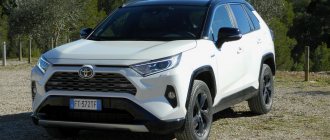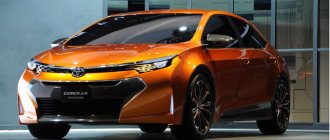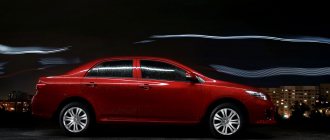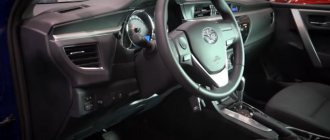The third generation of the Toyota Prius hybrid car was introduced in May 2009. Production of the model continued until 2015. The design of the hybrid has almost completely changed. More efficient operation of the internal combustion engine at lower speeds was achieved, which led to fuel savings. A new transmission with a hybrid installation has been developed to ensure a smooth and dynamic ride.
On October 19, 2009, the Prius 30 began officially being sold in Russia.
Body and interior
Prius before restyling
When developing the body of the Toyota Prius 30, the designers were faced with the task of obtaining a reduced aerodynamic drag. As a result, it was possible to achieve a coefficient value of 0.25, with the classic design of the body shape in the form of a triangular profile. Due to the flat shape of the outer sides of the bumpers, it was possible to direct the air flow around the wheel arches.
Compared to the previous generation Toyota Prius, the body dimensions have been changed. This manifested itself in an increase in length and width. The highest point of the car has moved towards the rear. This contributed to increased space for rear passengers.
Prius 30 after 2012 update
The interior of the Prius 30 stood out with its front panel. The torpedo was divided into two zones. An information display was located in the central upper part, and push-button controls were located on a towering asymmetrical lower console. A new steering wheel shape has been developed. A ten-millimeter cut was formed at the bottom of the steering wheel, which increased the space for the driver’s legs.
The shape of the front seats is more comfortable. At the same time, the width of the seat back has been reduced, which has led to increased legroom for rear passengers.
Front seats
A new modification of the air conditioner was used, which significantly reduced electrical energy consumption. A remote start function for the air conditioning system was provided.
New driving modes have been developed for the third generation Toyota Prius. Among them:
- Electric (EV) - forced activation of the electric motor. In this case, the speed is limited to 50 km/h, and the distance traveled is limited to two kilometers;
- Dynamic (PWR) - the sensitivity of the gas pedal was automatically improved;
- Economical (ECO) - there was a decrease in the response of the gas pedal to sudden pressing. The load on the air conditioner was also limited.
Hybrid powertrain
The developers of the third generation Toyota Prius decided to use a 1.8 liter internal combustion engine in the hybrid unit. This made it possible to reduce fuel consumption by ten percent due to engine operation at low speeds.
Additional exhaust gas cooling was used. This ensured that the best conditions were created for the catalytic converter to operate.
Under the hood of Toyota Prius 30
The gasoline power unit did not use drive belts. The rotation of the pump and air conditioning compressor was carried out using electric motors. To reduce noise and vibration, a cylinder block with increased rigidity was used. Its installation was carried out on four rubber supports, consisting of dampers with two stages.
The transmission was modernized by increasing the compactness of the generator, electric motor and planetary gearbox, which made it possible to eliminate the chain drive. Translational rotation from the gearbox was directly transmitted to the main gear. The dimensions of the battery have been reduced, which has contributed to an increase in luggage space.
Pros and cons of the Prius 30
The following characteristic disadvantages are noted in the operation of the third generation Toyota Prius:
- low ground clearance, which increases the likelihood of damage to the bumper or underbody of the car;
- jamming of brake calipers as a result of souring;
- problems with the steering rack, which may appear after 50,000 km;
- unreliable coolant pump. The level of antifreeze in the expansion tank should be monitored. This is due to the fact that when the pump fails, the inverter is left without cooling and also breaks down;
- long periods of downtime in severe frosts have a negative impact on the battery and can cause complete failure of the battery;
- According to factory regulations, if at least one battery element breaks down, the entire battery will need to be replaced. In practice, it is possible to replace the damaged part even on your own. You will first need to study the operating instructions for the Toyota Prius 30 in Russian.
At the same time, one cannot fail to note the obvious advantages of the Prius 30 hybrid:
- increased power;
- low fuel consumption;
- increased reliability of the power unit compared to the Prius 20.
The trunk of the Prius 30 is not small at all.
And everything else
Even old Prius XW20s only rust after a bad restoration. If everything was done “for oneself” and not for sale, there will be no serious problems with rust even on “older” copies. Newer generations can even more please you with a strong body. For example, many cars do not have mudguards, which is why the bottom of the body is sandblasted, but still does not “bloom.” Ordinary electrics are also pleased with good reliability, except that age-related problems with the equipment may arise on the XW20.
On the XW20, the wheel bearings are considered the weak point; sometimes they do not provide good service life on the XW30 either - they have to be replaced after 60-80 thousand km (140-230 rubles per hub, 70 rubles for labor). But otherwise the chassis is very strong and durable. It’s very significant: many XW20s still drive with “original” ball joints (60 rubles for a part, 45 rubles for labor), and even the youngest copies are more than 10 years old! Silent blocks (80 rubles for parts, 180 rubles for labor) in the levers are also changed only on 15-year-old cars. The other side of the coin: due to the fact that the suspension does not require intervention for so many years, the fasteners become sour, which makes it difficult to carry out work
The handbrake cables also become sour due to inactivity - after all, the parking brake should be used periodically. Also, over time, the guides of the rear calipers begin to jam. But there is no such problem with the front brakes - they have a plastic cylinder and an aluminum piston. Well, since the Prius is a hybrid, the pads (50 rubles) easily last 100 thousand km, the discs (160 rubles) - 200-250 thousand km.
Specifications
In this section, we will present in detail the main indicators of the III generation Toyota Prius, including dimensions, volumes, safety system and characteristics of the hybrid power unit.
Dimensions and volumes
The Toyota Prius 30 hatchback was produced with the following body dimensions:
- length - 446 cm;
- width - 174.5 cm;
- height - 150 cm.
The salon is designed to accommodate five people. For this purpose, two rows of seats are installed. The interior dimensions have the following indicators: L x W x H - 1905 x 1470 x 1225 millimeters. At the same time, the trunk volume is 446 liters, and with the second row seats folded, 1545 liters. The wheelbase of 270 cm allows for a minimum turning radius of 5.2 meters. The ground clearance (clearance) is 140 mm.
The car is equipped with a fuel tank of forty-five liters.
Characteristics of the hybrid power unit
The Toyota Prius 30 used a hybrid consisting of a 1.8 2ZR-FXE four-cylinder petrol power unit and an electric motor using a 1.3 kWh battery.
Under the hood of a Prius 30
The power of the electric motor is 60 kW. In this case, the torque of the electric motor is 207 N*m.
The exact volume of the 2ZR-FXE gasoline engine is 1797 cc. cm, with a compression ratio of 13. The power unit uses a dual VVT-i system. The maximum power and torque of the internal combustion engine engine is 99 hp. and 142 N*m, respectively.
Using a hybrid results in an average fuel consumption of 3.9 liters per hundred kilometers.
This generation introduced the plug-in Prius. But this is a topic for a separate article
Safety
The 2009 Toyota Prius uses active and passive systems to ensure safety.
The passive safety kit involved the use of high strength steel in the manufacture of the body. In this case, crushable zones were provided. A special front bumper design was developed. It made it possible to prevent a person from falling under the wheels of a car in the event of a collision with a pedestrian. This design also reduced the likelihood of leg injuries and made it possible to soften the force of a head impact due to the deflection of the hood. There is also provision for the installation of seven airbags and an ISOFIX mount for child safety. The airbags can protect against direct and lateral collisions.
Airbags Prius 30
The active safety package consists of the following electronic systems:
- stability control (ESP);
- anti-lock braking system (ABS);
- hill start assist (HAC);
- emergency braking (BAS);
- traction control (TCS);
- additional brake force control (EBD);
- tire pressure monitoring.
Toyota Prius III XW30
A fashionable gadget, a toy for older children or a practical means of transportation. This car can be perceived in different ways, but the fact remains that the Prius is interesting to a very wide audience. However, for many, the new hatchback is prohibitively expensive. Believe me, the car of the previous, third generation is hardly worse
Let's face it, with the loudly declared fantastic efficiency of the Prius - according to the passport data, the third-generation model in the combined cycle consumes 3.9 l/100 km - the real fuel consumption is noticeably higher. We operated a Japanese hybrid for quite a long time in Moscow, where the car required from 5.5 to 6 liters of gasoline for the same “hundred” mileage. On the highway, where the gasoline engine not only plows alone almost all the time, but also carries a 45-kilogram high-voltage battery on its shoulders, the flow meter showed 7-7.5 l/100 km. Twenty years ago, these were practically unattainable figures for golf-class cars with naturally aspirated engines and automatic transmissions, but now, in the era of global downsizing of engines and the introduction of start-stop systems, cars with traditional power plants have learned to drive no less economically.
It’s not just that I mentioned the Prius’s twenty-year presence on the market. Over the past years, the technical concept of the machine has not changed at all. This is a body with a low aerodynamic drag coefficient and a power unit packed into it, consisting of a high-voltage battery, a gasoline engine, a starter-generator and an electric motor. The playing of this quartet is conducted by an inverter and a planetary gearbox, which allows the car to move forward or backward, as well as maintain engine speed in optimal modes.
At the same time, remaining faithful to the general idea, each new generation of Prius entered the market with something new. Perhaps the main technical difference between the third generation car (XW30) and its predecessor was the 2ZR-FXE gasoline engine. The tandem of this 1.8-liter (previously 1.5-liter) gasoline four with an electric motor develops 136 hp. Not enough, you say? This, by the way, is 14 “horses” more than the current fourth Prius. And it’s not, in fact, what’s great about them, but the impressive torque, which ensures brisk starts and lively dynamics in the city. However, for those looking for an aftermarket hybrid Toyota, its reliability is no less important than the speed it develops. This is not an idle question, especially since you can’t buy a five-year-old Prius from us for less than 650 thousand rubles. This is what they ask for for right-hand drive models; left-hand drive cars are on average 150 thousand rubles more expensive. As you can see, the amounts are decent.
On many forums you can find remarks that Priuses have a significantly longer service life than regular cars. Yes and no. You can’t argue with the fact that the parts of the hybrid brake system (pads and discs) are subject to minimal wear, since the starter-generator does a significant job of slowing down the car in recuperation mode. The gasoline engine also gets less, since its speed does not leave the optimal zone, and often movement occurs only due to electric traction. In general, with normal care, timely replacement of oil and filters, the internal combustion engine, and with a mileage of 300 thousand km, it is in perfect health. But whether this engine can last another hundred thousand without repair is a question.
But counting on the eternal life of shock absorbers, silent blocks, and suspension stabilizer struts is naive. These Prius parts are subjected to the same loads as those on a Corolla of similar size and weight. Consequently, their service life is approximately equal. Finally, about the most exciting thing - the traction battery. The thing is really tenacious (designed for the entire life of the car, that is, 300-350 thousand km), it is difficult to kill, but still possible. Therefore, do not skimp on a comprehensive check of the copy you like in an authorized or verified club service. Like all similar batteries, the Prius battery does not tolerate overheating, therefore you need to carefully monitor the condition of its cooling fan, and under no circumstances carry out welding work in the immediate vicinity - for example, during body repairs. Another piece of advice from experienced car drivers is to not leave the car for a long time (two weeks or more) without moving. If the battery is empty, the car will not move, and the internal combustion engine will only start when moving. There is only one way out in this situation - a tow truck and a trip to the dealer.
Suspension
The chassis is quite simple: there are McPherson struts at the front and a torsion beam at the rear. There are no systemic problems with the chassis. Only planned replacements. Shock absorbers serve an average of 60-80 thousand km. (5000-6000 rubles per piece). At the same time, it is optimal to change the bushings (RUB 250-A00) and struts (RUB 1,700-2,300) of the front stabilizer
Transmission
Here again everything is very simple. The function of transmitting traction from a gasoline and electric motor to the wheels is assigned to a planetary gearbox, which also acts as a gearbox. It takes a lot of effort to kill him. However, service technicians recommend changing the oil in this unit every 60 thousand km. The issue price is 3000 rubles.
Engine
For better efficiency, the Prius is equipped with a gasoline engine operating on the Atkinson cycle. In such an engine, the compression stroke is shorter than the power stroke. But you don’t need to know this at all, because scheduled maintenance of this unit is no different from caring for an ordinary engine. That is, we change the oil and filters every ten thousand, in extreme cases - every 15 thousand.
Body
High-quality preparation and painting of the body protects it from corrosion for a long time. However, not a single used car is immune from chips, which, after contact with reagents, can turn into quite large ulcers. The plastic face is not in danger of such a misfortune, but we recommend that you inspect the windshield pillars and sills with passion.
Electrics
Avoiding overheating is the main condition for extending battery life. However, if it fails, it is not always necessary to purchase a new battery (65,000 rubles). More often you can get by by replacing several blocks that make up the battery. They are completely interchangeable and, depending on the region and the seller, cost about 2000-3000 rubles apiece.
Advantages and disadvantages
+ Real fuel economy in urban modes, positive image, spacious interior, roomy trunk, commendable reliability with proper care
— Long warm-up of the interior at low external temperatures; in order to avoid discharge of the traction battery, long periods of downtime without movement are unacceptable
Restyling
The modernization of the 2013 Toyota Prius was accompanied by changes in the external and internal design. At the same time, the car has not changed in terms of the technology used. The differences between the Prius 30 and the pre-restyling version were as follows:
Updated Prius 30
- an LED side light strip was added to the front optics;
- new front and rear bumpers;
- the shape of the rear lights has been changed;
- fog lights moved closer to the license plate;
- Daytime running lights were installed in place of the fog lights;
- the function of folding external mirrors has been added;
- the color of the discs changed to black with the use of a silver cap;
- a new head unit was installed with identical functionality, but fewer buttons;
- The armrest has been replaced and has a USB input;
- two-color eco-leather seats were painted;
- The emergency stop button is now red.
Environmental friendliness
The Toyota Prius III used specialized bioplastics to produce interior elements. The headrests of the seats and the exterior trim of the dashboard were made using vegetable foam.
The batteries were recycled, almost one hundred percent. Old batteries were dismantled in specialized services. Subsequently, the items were sent for recycling. It consisted of separating wires, electronics and metal housings for reuse. As well as the subsequent decomposition of the battery into water, organic substances and nickel, using a special technique.
Exterior view of Toyota Prius 30 body
Toyota Prius in body 30 is produced from 2009 to 2021. Compared to the 20th model, in the third generation the aerodynamic performance of the body has significantly improved (the drag coefficient has changed to 0.25). At the same time, the classic proportions of the car remained virtually unchanged. The operation of the Toyota Prius 30 body is designed for a long period, so it is made mostly of high-strength steel, using special designs that increase the safety of the car.
The height of the car has not changed, the length has become 4460 cm, and the width has become 1745 cm. The highest point of the roof has been moved back, which has increased the space above the rear seats of the car. The A-pillars have moved forward, resulting in an increase in the angle of the windshield and the size of the side windows. Such changes, combined with the expansion of the rear window, significantly increased the driver's visibility.
In 2011, the body of the Toyota Prius 30 underwent new changes; a restyled model was released, equipped with a new front bumper and updated headlights with LEDs. Thanks to the new shape of the bumper (enlarged air intake and additional fog lights), the car's appearance has become aggressive.
- Toyota Prius III: 2009-2016
- Body (hatchback): DAA-ZVW30
- Body dimensions: 4460 x 1745 x 1490 - 1505 (cm)
- Weight: from 1310 to 1495 kg.
- Ground clearance: 140 mm.
- Tire diameter: 185 /65 / R15-17
XW50 2015 present
The fourth generation of Toyota Prius hybrids has gone even further in a number of technical characteristics, although in some ways it has become inferior to the previous one. The maximum possible speed of the new cars remained at 180 km/h. Acceleration time to 100 increased slightly and amounted to 10.6 seconds. The determining factor was reduced fuel consumption.
Fourth generation sizes
In the fourth wave of Toyota Prius cars, the ground clearance decreased by 4 mm compared to the representatives of the previous series. The body has become more massive:
- dimensions – 4540*1760*1470;
- distance between axles – 2700;
- The trunk size has increased to 501 liters.
Tank capacity was reduced to 43 liters. The wheel size remained the same - 195/65 R15, but they were redesigned, resulting in a 30% increase in rigidity. The minimum turning radius decreased slightly - 5.4 m. The aerodynamic drag coefficient improved by one tenth (0.24).
The Prius has a decent size trunk.
Characteristics of the hybrid power plant
In the latest generation power plant, the location of the electric motors has changed. Instead of placing them on the same axis, the developers decided to place them parallel, next to each other. As a result, transmission losses were reduced by 20%. New for the Japanese is the ability to order a Prius with all-wheel drive (scheduled for entry into the American market in 2019).
The gasoline unit was modified to increase performance and reduce weight. As a result, the installation received the following characteristics:
- volume 2ZR-FXE – 1797 cc. (1.8-liter internal combustion engine);
- engine power – 99 hp at 5200 rpm;
- the torque of the 2ZR-FXE is 142 N*m at 3600 rpm.
- the compression ratio remained the same - 13;
- fuel used - AI-92;
- gasoline consumption decreased to 2.9 when driving in the urban cycle, 3.1 when driving on the highway, 3.0 when driving in a mixed cycle.
Under the hood of the Prius 50,
the electric drive of the hybrid power plant has undergone some changes (to a lesser extent), its main characteristics look like this:
- electric motor torque – 163 Nm;
- electric motor output – 53 kW;
- high-voltage battery capacity – 6.5 Ah.
It was on the basis of the fourth generation Priuses that the Prius Prime hybrids were created in 2021 - cars recharged from an external electrical network, aimed at the North American market.
Toyota Prius (ZVW30) equipment
The main change in the interior configuration of the Toyota Prius 30 was the front panel, divided into two zones. The car's control system is located lower than in the second generation Prius. Above it is a lever for changing driving modes. The height of the steering wheel is cut by 10 cm, which allows the driver to feel more comfortable. The convenient location of the head display allows you to instantly receive the necessary information.
The design of the seats in the Toyota Prius in the 30th body has been changed. The front backrests are adjustable and have become significantly narrower, which provides greater comfort for passengers sitting in the back. Thanks to a more compact battery cooling system, it is possible to expand the trunk volume by 30 liters, the total size of which is 445 liters, and with the rear seats removed - more than 1,100 liters.
Equipment options
Basic version - Prius 30 L configuration:
- Keyless access to driver's door.
- Wheels R15 (alloy).
- Caps that improve aerodynamics.
- Headlights with lenses.
- Multi-system steering wheel.
- Additional turning lights on the side mirrors.
- Start the engine using a button.
- Electric vehicle and fuel economy modes (EV Mode, ECO/PWR).
The S package, unlike the base one, has the following added:
- Armrest for rear seats.
- The armrest between the front seats is retractable.
- Height adjustment system for the driver's seat.
- Rear window wiper.
- Anti-fog optics.
- Curtains in the trunk.
- Hard plastic tray in the trunk.
- Leather steering wheel, sunroof, solar panels, hood insulation, smart key on the passenger door.
Equipment S Led edition:
Photo of the S Led edition Toyota Prius 30 (open)
- LED headlights with lenses.
- Optical washers.
- Alcantara interior (2-color layout possible).
- Leather-wrapped steering wheel.
S TOURING SELECTION:
- Alloy wheels R17.
- LED headlights with lenses and washer.
- If there is a standard hydraulic booster, car parking.
Equipment S TOURING SELECTION MY COORDE (restyled models from 12.2011):
Photo of S Touring Selection MY COORDE (open)
- The bumper has changed.
- Leather interior (light with dark color combination).
- Leather-wrapped steering wheel.
Maximum configuration G:
- Luke.
- Ventilation in the cabin using a solar panel in the parking lot.
- Availability of cruise control.
- Alcantara upholstery.
- Leather steering wheel.
- Smart key for front and rear doors.
- The hood is equipped with noise and heat insulation.
Winter equipment for Toyota Prius (rarely found) can be an addition to any equipment:
- Heated mirrors, wiper coverage and rear fog lamp.
- Presence of heating elements in the stove.
Specifications
Compared to second-generation cars, the Toyota Prius 30 engine has increased its volume, resulting in increased engine power.
Toyota Prius 30 engine:
- Engine: 1.8 CVT 2ZR-FXE
- Volume: 1794 cc
- Power (hp / kW / rpm): 97 / 73 / 5200
- Torque (Nm/rpm): 142 / 4000
- Fuel supply: injector
- Fuel: gasoline AI 95, AI - 92
Electric motor:
- Power (kW/rpm): 82/153
- Torque: 207 Nm
- Maximum voltage (V): 650
Accumulator battery:
- Type: Nickel-metal hybrid
- Capacity (Ah): 6.5
- Voltage (V): 201.6
Fuel consumption of a Toyota Prius hybrid (depending on the model and weather conditions) varies from 3 to 6 liters of fuel. Performance characteristics of the third generation Toyota Prius hybrid:
- Ability to accelerate to 100 km/h: 10.4 seconds
- Maximum possible speed: 180 km/h
Reliability, shortcomings and repair cost of Toyota Prius
Suspension
The chassis is quite simple: there are McPherson struts at the front and a torsion beam at the rear. There are no systemic problems with the chassis. Only planned replacements. Shock absorbers serve an average of 60-80 thousand km. (5000-6000 rubles per piece). At the same time, it is optimal to change the bushings (250-400 rubles) and struts (1700-2300 rubles) of the front stabilizer
Transmission
Here again everything is very simple. The function of transmitting traction from a gasoline and electric motor to the wheels is assigned to a planetary gearbox, which also acts as a gearbox. It takes a lot of effort to kill him. However, service technicians recommend changing the oil in this unit every 60 thousand km. The issue price is 3000 rubles.
Engine
For better efficiency, the Prius is equipped with a gasoline engine operating on the Atkinson cycle. In such an engine, the compression stroke is shorter than the power stroke. But you don’t need to know this at all, because scheduled maintenance of this unit is no different from caring for an ordinary engine. That is, we change the oil and filters every ten thousand, in extreme cases - every 15 thousand.
Body
High-quality preparation and painting of the body protects it from corrosion for a long time. However, not a single used car is immune from chips, which, after contact with reagents, can turn into quite large ulcers. The plastic face is not in danger of such a misfortune, but we recommend that you inspect the windshield pillars and sills with passion.
Electrics
Avoiding overheating is the main condition for extending battery life. However, if it fails, it is not always necessary to purchase a new battery (65,000 rubles). More often you can get by by replacing several blocks that make up the battery. They are completely interchangeable and, depending on the region and the seller, cost about 2000-3000 rubles apiece.
Owner reviews
Owner reviews of the Toyota Prius in the 30th body are the main indicator of the positive and negative qualities of the car:
- A reliable and economical car, it has already driven more than 90 thousand km. Gasoline consumption is on average about 5 liters, and during this time, apart from maintenance, repairs have never been needed.
- I bought a Prius 30 a year ago, I like everything about the car, but there is one thing: it is very noisy in the cabin.
- Before buying a car, I read reviews of the Toyota Prius 30 body on the Internet. To be honest, I didn’t believe that everything written was true. After the purchase, I was pleasantly pleased with the ease of starting the car in cold weather and the low gas consumption even in winter.
Price for Toyota Prius 30 body in Vladivostok
Below are prices for a Toyota Prius in body 30, year of manufacture, and equipment.
Toyota Prius 30 body without mileage, 2012 in Vladivostok, 830,000 rubles (close)
- Equipment S
- There is xenon in the headlights
- Fogs in the bumper
- Modern radio (bluetooth, etc.)
- Standard reversing camera with trajectory
- Wind deflectors
- Rugs
- Shelf in the trunk
- Alloy wheels with summer tires
- Auction sheet: 3.5 points
- Price Toyota Prius 2012: RUB 830,000
Information from the website drom.ru / updated 08/14/2018
Toyota Prius 30 body without mileage, 2011 in Vladivostok, 775,000 rubles (close)
- Vehicle mileage: 117600 km
- Engine capacity: 1.8 liters
- Equipment: L-led edition
- Headlights: LED with lenses, headlight washers
- Rear camera with trajectory markings
- Leather steering wheel
- Interior upholstery Alcantara
- Modern radio (bluetooth, TV, DVD-video, HDD, etc.)
- There is cruise control on the steering wheel
- Smart Key system installed
- Rubber on alloy wheels 17
- Price Toyota Prius 2011: RUB 775,000
The car is cleared through customs in Vladivostok, Glonass is installed (button), the recycling fee is paid.
Dynamics and innovation
Dynamics
The dynamic performance of the motor, running on electricity and gasoline, helps the vehicle start silently from a standstill, respond quickly when driving around the city, and quickly accelerate in any of three driving modes: ECO, NORMAL or POWER. During dynamic driving (POWER), the DMD system is activated.
Innovation
The task of designers using innovative technologies when creating a new passenger car model is to develop an economical two-zone climate control system that maintains a comfortable temperature in the cabin, regardless of the number of passengers.
The function of braking and alerting the location of a pedestrian, an extraneous vehicle or a stationary obstacle was highly praised by experts. The system is functional when driving at any speed, issues a warning about crossing road markings, automatically switches high and low beam headlights, recognizes road signs, and sounds a sound signal when reversing.
Introduced in 2015, the new model of the eco-car Toyota Prius still occupies a leading position in the series of powerful, fast, elegant, safe and functional monsters that meet the requirements of international standards.
Weaknesses and disadvantages of a used Toyota Prius 30
One of the most interesting solutions in the automotive industry is the emergence of hybrid engines.
Cars of this kind are designed to minimize fuel consumption, as well as serve their owner faithfully. Among the most popular cars with a hybrid engine is the Toyota Prius ZVW30. Today it is considered one of the best in its class. But there is also an opinion that the third generation Prius is a rather mediocre car with many problems. Therefore, in order not to unfoundedly voice specific information, it is worth finding out what shortcomings the Prius has, and whether it is worth buying it. Specifications:
- Modification (engine): 1.8 CVT (100 kW (134) hp/5200 rpm), Multipoint injection, hybrid petrol;
- Transmission: ECVT (CVT)
- Maximum speed: 180 km/h;
- Suspension type:
- Front suspension - Independent - McPherson;
- Rear suspension - Semi-independent
- Ground clearance: 140 mm
- Tire sizes and wheel: P195/65 R15
- Body type: Hatchback
- Average fuel consumption: 1.8 CVT - 3.9 l./100 km.
- Load capacity: 435 kg.
The Toyota Prius has easily taken the lead among hybrid vehicles. It was easy, since there is not much competition in this market segment. Only Honda was able to put a hybrid car with a fairly competitive modification on the market, but Toyota still beat it in all respects.
But, if we take into account all the cars in this class, the Toyota Prius will be approximately in the middle of the rating. Now sales of this car are stable, but they fall far short of those planned by the manufacturer. A number of shortcomings and frankly weak points make drivers regret their choice.
What’s most interesting is that the first generation Prius, which was first released back in 1997, has the fewest complaints. The second generation Prius, in the NHW20 body, and the third generation Prius in the ZVW30 body were developed based on it.
Modifications
The third generation Prius family turned out to be the most prolific, not only in terms of the amount of copies sold in the world, but also in the number of modifications. In addition to the regular version, the Japanese introduced a rechargeable hybrid (ZW35) with a traction battery with a capacity of 21.5 Ah to the market in 2009. It takes an hour and a half to fully feed this battery from a 220 V network. But then you can drive only on electric power for 23 km. Two years later, the Prius V station wagon appeared in the noble hybrid family with a standard power plant, but a trunk increased by 50%. In the States, this car was offered in a five-seater version, and in Japan and European countries seven-seater cars were sold.
Toyota Prius I generation (NHW10). Produced from 1997–2003, price on the secondary market from 150,000 rubles.
Toyota Prius II generation (NHW20). Produced from 2003–2012, price on the secondary market from 430,000 rubles.
Toyota Prius IV generation (XW50). Produced since 2015, price on the secondary market starts from RUB 1,600,000.
pros
- Real fuel economy in urban modes
- Positive image
- Spacious salon
- Spacious trunk
- Commendable reliability with proper care
Weaknesses of the third generation Toyota Prius
- Fuel system;
- Hybrid system;
- Inverter and inverter cooling pump;
- Salon.
Let's look at it in more detail...
Fuel system.
First of all, Prius owners note that the car’s fuel consumption is much higher than stated. When repairing the fuel system, a new unpleasant surprise awaits you. For some reason, the fuel filter was placed in the gas tank, which makes repairs very difficult and raises the price.
The first thing that catches your eye immediately after purchase (according to eyewitnesses-owners) is higher fuel consumption than stated. But... it’s worth noting right away that the indicators announced by the manufacturer are achievable during normal driving on city roads or on the highway. In reality, this is also supplemented by the operation of the audio system, air conditioner or stove (in summer and winter, respectively) and other factors that increase consumption. Without this, the numbers on the information board correspond to those stated. The only exceptions may be cars whose mileage has exceeded 250-300 thousand km - here we can really talk about increased fuel costs.
Hybrid system.
It is, in principle, the same as in the second generation Prius, but at a higher level. The electric motor is now more powerful; its connection to the gasoline engine is still ensured by a planetary gear. But this led to excessive noise at high speeds. Also, the updated system operates very unevenly at idle.
According to the manufacturers, this car is completely designed for driving around the city and, with proper operation and timely maintenance, it will not require repairs or replacement of any parts for a long time. In fact, it turned out to be the opposite.
Here there are two possible types of malfunctions that may arise during the operation of the car.
- The first is a breakdown of the inverter: the cost of this part is quite high, but... when purchasing it from an official dealer. Practice shows that buying parts in regular auto parts stores is much cheaper, so solving this issue does not seem difficult.
- The second problem with this engine is the batteries: if one or a couple of elements fail, official workshops will insist on a complete replacement of the entire unit, which will cost a pretty penny. In reality, you can replace (even on your own, after reading the necessary information) non-working elements and continue driving.
- Problems when operating in areas of low temperatures Priuses equipped with a lithium-ion battery, after 2010 they began to be installed on the Toyota Prius PHV (35 body), Prius Alpha ZVW-40 (7 seats), Prius V, Prius+, also the fourth generation Prius (ZVW51). Li-Ion has become much more compact due to which in some models it is located between the front seats, but is sensitive to frost, unlike nickel-metal hydride (Ni-MH).
Inverter and inverter cooling pump.
The cooling pump for the inverter has obvious disadvantages, as it often breaks down. The driver needs to carefully monitor its condition, as the inverter also instantly overheats and must be replaced.
Frequent breakdowns occur in the inverter cooling pump if for some reason the level of antifreeze in the tank drops. A pump malfunction causes the inverter to overheat and, of course, it becomes completely unusable and requires complete replacement. The price of an inverter, if you can find one, reaches one hundred thousand rubles.
Advice! Prius owners should closely monitor the presence of antifreeze in the pump reservoir and any warning signals from the vehicle's computer. The cooling system is the weak point of this model and can present a lot of surprises.
Salon.
For unknown reasons, the front panel of the Toyota Prius was made following the example of sports models. The owner of such a machine does not really like this, especially since there are many buttons on it in an inconvenient order. The designers didn't care about an intuitive control panel, they just wanted to improve the second generation version as much as possible.
While using the car, it becomes clear that low-quality materials were used to decorate the interior. They peel off on their own and the plastic parts begin to rattle.
Legends and reality
On many forums you can find remarks that Priuses have a significantly longer service life than regular cars. Yes and no. You can’t argue with the fact that the parts of the hybrid brake system (pads and discs) are subject to minimal wear, since the starter-generator does a significant job of slowing down the car in recuperation mode. The gasoline engine also gets less, since its speed does not leave the optimal zone, and often movement occurs only due to electric traction. In general, with normal care, timely replacement of oil and filters, the internal combustion engine, and with a mileage of 300 thousand km, it is in perfect health. But whether this engine can last another hundred thousand without repair is a question.
In 2011, the Japanese released an updated version of the third Prius. The designers slightly retouched the exterior of the car, and the designers installed a new multimedia system with a 6.1-inch screen in the cabin.
Practicality is one of the main trump cards of this car. In terms of comfort and spaciousness of the sofa, the Prius is not inferior to middle-class models. And summer residents will not lose out. The minimum trunk volume is 445 liters. Maximum, with seats folded - 1220 l
But counting on the eternal life of shock absorbers, silent blocks, and suspension stabilizer struts is naive. These Prius parts are subjected to the same loads as those on a Corolla of similar size and weight. Consequently, their service life is approximately equal.
Finally, about the most exciting thing - the traction battery. The thing is really tenacious (designed for the entire life of the car, that is, 300-350 thousand km), it is difficult to kill, but still possible. Therefore, do not skimp on a comprehensive check of the copy you like in an authorized or verified club service. Like all similar batteries, the Prius battery does not tolerate overheating, therefore you need to carefully monitor the condition of its cooling fan, and under no circumstances carry out welding work in the immediate vicinity - for example, during body repairs.
Another piece of advice from experienced vehicle drivers is to not leave the car for a long time (two weeks or more) without moving. If the battery is empty, the car will not move, and the internal combustion engine will only start when moving. There is only one way out in this situation - a tow truck and a trip to the dealer.











